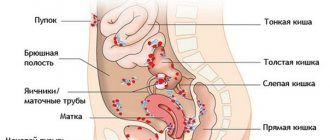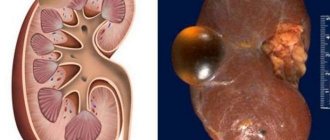Indications for use
Ultrasound in gynecology is a reliable, accurate way to detect diseases in this area. If the patient feels discomfort or pain in the lower abdomen, she should urgently seek advice from a specialist who may recommend undergoing an ultrasound scan of the internal female organs.
When is a gynecological ultrasound performed?
Ultrasound hardware diagnostics is prescribed by a doctor if the following symptoms or conditions are identified during the initial examination or interview with the patient.
- Deviations of the menstrual cycle: occur prematurely or are delayed, excessively abundant or scanty. Such changes are indicators of the appearance of formations, disturbances in the functioning of the ovaries, endometrial polyps, and so on.
- Painful menstruation. The gynecologist may suggest inflammation of the uterus, ovaries, and fallopian tubes.
- Discharge. Adhesions, tubal pregnancy and cysts have this manifestation.
- Monitoring the dynamics of fetal development. Early diagnosis of congenital anomalies.
- Determining the causes of infertility.
- Diagnosis of inflammation associated with the installation of contraceptives (coils, caps).
- Urinary incontinence.
- Different types of pregnancy termination.
- Routine ultrasound in gynecology to detect neoplasms when they are asymptomatic.
- Ultrasound screening of female genital organs as part of a regulated medical examination.
How to prepare for a gynecological ultrasound
The purpose of preparing for the procedure is to free the intestines from gases and feces. This will create optimal conditions for waves to penetrate and display a reliable picture on the screen. Preparation for ultrasound in gynecology should begin 3-4 days before the examination. To reduce gas formation, a woman needs to eat properly and follow a diet, excluding the following from the list of products:
- beans, beans, peas;
- fruits and vegetables with a high fiber content that have not undergone heat treatment;
- milk. Fermented milk products are allowed;
- black bread;
- carbonated drinks, strong tea and coffee;
- sweets.
For digestive problems, doctors advise taking the enzymes Enzistal, Festal, Creon. Espumisan and other simethicones help remove gases. For those suffering from constipation, laxatives are prescribed. The use of enemas to cleanse the intestines is not recommended, since they provoke retention of air and gases in its lower sections.
Bladder filling is required if an abdominal examination is ordered. It is recommended to drink 1.5 liters of water an hour before the examination. These rules depend on the patient’s age, whether she has heart disease, vascular disease or kidney disease.
The same principles of preparation for the study apply before sonography for pregnant women. It is carried out at the 10th...14th obstetric weeks and can already show what disorders the fetus and the mother’s reproductive system have.
Preparation for the transvaginal pelvic ultrasound procedure
Transvaginal sonography is performed using an intravaginal probe. To comply with aseptic standards, a condom is put on it before use.
Diagnosis through the vagina is considered the most informative and is performed with a moderately full bladder. In addition, performing a colonoscopy or gastroscopy before an ultrasound does not affect the diagnostic results. The transvaganal examination procedure is not prescribed for patients with large tumors in the pelvis and virgins. Preparing for an ultrasound using this method comes down to hygiene of the external and internal genitalia before visiting a doctor.
If after the procedure you experience a burning sensation in your intimate areas or heavy vaginal discharge, consult your doctor.
On what day of the cycle is it better to do a gynecological ultrasound?
The physiological characteristics of the female body suggest the optimal period of examination in the first 3-5 days after the onset of menstruation. Doctors do not recommend performing an ultrasound examination later than the 8th...10th day of the cycle. The appointment of the procedure for the first phase of the cycle determined the state of the endometrium, which during this period has minimal density. Through the thinned layer of the membrane, pathologies, polyps, cysts, and fibroids are better visible. In the second phase of the cycle, the shell thickens significantly, and many deviations may go unnoticed. After the second phase of the cycle, small cysts (up to 2 cm) are likely to appear in a woman’s ovaries. These may be formed follicles in the ovaries, one of which will soon ovulate, or a corpus luteum cyst. At this stage, it is difficult for doctors to determine the structure of such formation.
The procedure can be performed before the onset of menstruation to diagnose the presence of a follicle and determine whether ovulation has occurred. Such examinations are usually prescribed to women diagnosed with infertility or preparing for IVF. In the case of assessing the dynamics of the ovaries, ultrasound is performed three times: on the 8th...11th days of the cycle, on the 15th...18th days, on the 23rd...25th days.
If there are serious complications, the study can be carried out regardless of the dates of the menstrual cycle. These are:
- sharp pain;
- heavy bleeding;
- suspicion of tubal, cervical and ovarian ectopic pregnancy;
- presence of a foreign body;
- removing the spiral.
Transrectal gynecological examination using ultrasound
This type of examination of the pelvic organs is prescribed to girls in order not to damage the integrity of the hymen or if there are contraindications to other methods of ultrasound gynecological examination of the female organs.
Having received an appointment for a transrectal ultrasound, you should first:
- avoid gas formation in the intestines by eliminating some foods from the diet 3 days before the examination;
- come to the procedure on an empty stomach;
- do cleansing enemas the night before and in the morning before the examination;
- a few hours before the test, stop smoking, as it increases intestinal motility.
For transrectal examination, you will need a condom (regular or special for ultrasound), which the doctor will put on the sensor.
Having received a referral for an ultrasound for a gynecological examination, check with your doctor at what period of the menstrual cycle the study will be most informative.
How is it carried out?
There are the following types (according to the method of performing) gynecological ultrasounds: transvaginal (through the vagina), transabdominal (through the anterior abdominal wall), transrectal (through the anus).
During menstruation
Is it possible to undergo an ultrasound examination if you are menstruating? This depends on which organs are being scanned. If the abdominal cavity is examined, then menstruation is not an obstacle to the procedure. To check the pelvic organs, it is better not to perform an ultrasound, since bloody discharge will create a painful environment for the examinee, and blood in the uterus will significantly complicate the examination and reduce its information content. If the diagnosis is carried out for serious reasons, and its significance is increased, then the session is scheduled no earlier than the 5th day, since by this time the discharge is already minimal, and the uterus has completely cleared of the old mucous membrane. In general, the presence of menstruation is not a contraindication for ultrasound.
Transabdominal
The procedure is more suitable for a general gynecological examination. For this to happen, the bladder must be full. Liquid (without gas) should be taken two hours before the examination. A full bladder moves the intestines into the lower cavity, which allows you to see in detail the ovaries and uterus, their appearance and condition. For ultrasound, a special sensor is used, which the diagnostician moves along the wall of the peritoneum, lubricated with gel for sliding.
Transvaginal
Transvaginal ultrasound shows the clearest picture of the condition of the uterus and ovaries. The doctor places a condom on a special ultrasound sensor, lubricates it with gel and inserts it inside. Patients are interested in how unpleasant it is, whether it will hurt to feel a foreign object. The process causes only mild discomfort and is absolutely harmless. The inserted sensor scans the internal organs of the small pelvis, and the doctor receives a complete picture on the screen. The procedure, unlike the transabdominal one, is performed when the bladder and intestines are completely empty.
Transrectal
The purpose of this study is to identify the causes of abnormalities in the pelvic organs using a special ultrasound sensor inserted into the anal canal. This method is used to test women who are not sexually active. Before such an examination, patients should take care in advance to cleanse the colon and empty the bladder.
How often can you do it
The frequency of ultrasound examinations in gynecology can only be determined by the attending physician. The harmlessness of ultrasound has long been proven by scientists:
- No negative effects of waves on humans have been identified. There are no examples of harm caused in medical practice;
- waves do not accumulate and do not change the state of the body and tissue parameters. The procedure is diagnostic and not therapeutic;
- Unlike X-rays and CT scans, ultrasound has no contraindications and is well tolerated even by children and pregnant women.
A case in point is that ultrasound technicians do not wear protective lead aprons even though they work with the machine all day. To maintain and prevent health, every woman should visit an ultrasound room at least once a year, and possibly more often.
The value of the method in gynecology
An ultrasound scanner is a multifunctional tool. Reveals pathologies, clarifies diseases, and helps monitor the effectiveness of therapy. And all this is absolutely harmless and can be repeated an unlimited number of times.
The procedure is an integral part of medical support during pregnancy and gives an idea of the intrauterine development of the fetus, without the risk of harming it.
If a pathology is suspected, the doctor may prescribe an ultrasound of the endometrium or pelvic organs, examine the peritoneum and the peritoneal space. The method detects urolithiasis and cholelithiasis, changes in the kidneys and bladder, the presence of blood clots, abscesses, tumor formations and cysts.
Interpretation of the results: pathologies and their echo signs
Decoding the results of a gynecological ultrasound poses a specialist not only the task of identifying deviations from the indicators that the norm suggests, but also differentiating these pathologies by type. Correct interpretation of the results is crucial for the choice of treatment. Ultrasonic waves travel in a straight line, collide with obstacles of different densities, are reflected and change their trajectory. The transducer reads the “history” of the movement of pulses and converts this data into a graphic image. The ability of tissues to reflect waves is called echogenicity. It is this indicator that the doctor studies. Analysis of the echogram allows you to determine the characteristics:
- position and dimensions (thickness, length, width) of the appendages, uterus and its cervix;
- echogenicity of other pelvic organs;
- indicators of the endometrial layer;
- the presence of follicles and their number;
- the presence of neoplasms and foci of inflammation, their localization, size, contours, partitions.
The information obtained from the patient is very important, since the sizes of the uterus vary - 4-8 cm (length) and 3-5 cm (width). It depends on the number of pregnancies and births. The presence of increased size in a nulliparous woman may indicate an inflammatory process or tumor.
What is the price
State compulsory compulsory medical insurance allows citizens to receive medical services free of charge. According to the policy, any woman can have an ultrasound of the pelvic organs in her clinic. However, to do this, she will need to pre-register (if there are places for registration) and patiently wait for her turn. The specifics of the procedure determine special deadlines for a certain type of procedure, and the date of the free ultrasound may simply not coincide with the optimal date for the ultrasound. Therefore, it is still better to contact specialized medical centers that perform ultrasound using high-precision equipment. The cost of diagnostics of the pelvic organs is on average 700 rubles. An ultrasound examination of pregnant women costs from 800 rubles, the price of an ultrasound of the mammary glands is from 600 rubles, folliculometry is 700-1000 rubles.
Transcription of research materials
After the procedure is completed, the diagnostician interprets the data obtained. The study protocol indicates the norm and, if any, deviations from it. Ideally, such a conclusion should be made by an obstetrician-gynecologist or urologist, that is, a doctor specializing in diseases of the female pelvic organs. During decoding, the position, size and structure of the uterus, fallopian tubes, ovaries, and bladder are assessed.
The presence or absence of stones in the bladder and kidneys, and formations in the large intestine are indicated. The presence of follicles in the ovaries and pathological formations in them is established. Various deviations from normal indicators indicate the development of diseases. For example, thickening of the walls of the uterus or fallopian tubes may be the development of oncological processes. Round-shaped formations diagnosed on ultrasound can be cysts or fibromas.
If there is a simultaneous decrease in the uterus and an increase in the size of the ovary, most likely we are talking about polycystic disease. A change in echogenicity indicates a fibroid (benign tumor of the uterus) or endometriosis. But the correct diagnosis can only be made by an experienced specialist who can take into account all the subtleties in the pictures or recordings. As a result, the decoding of the study materials contains the smallest details for each organ; on their basis, a conclusion is formed, which is given to the patient. After this, she can go to her doctor for further advice.
The body of the fair sex is a special mechanism in its structure, characterized by excessive fragility. That is why it requires increased attention and timely care. When situations occur that were previously not characteristic of the nature of a particular organism, the question arises of what to do.
In this case, you need to promptly seek help from a specialized ultrasound diagnostic center and make an appointment. Thanks to the research results, it is possible to completely cure ailments of the reproductive system in women.











